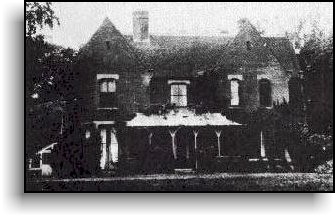
Borley Rectory
(Taken from the Occultopedia)

Borley Rectory
(Taken from the Occultopedia)
An unattractive Victorian brick building of many rambling rooms, damp, dark and uninviting, in the parish of Borley on the Essex-Suffolk border, made famous because of the violent controversy it stirred among modern psychical researchers, after Harry Price's "ghosthunting" investigations and his claim that it was "the most haunted house in England."
Local tales concerned a mysterious coach and horses which galloped along the roads; visions of headless men; a girl in white; sounds of dragging footsteps and other weird noises in the house. Above all, there was the apparition of a nun who occasionally walked the house and grounds.
The rectory was built in 1863 on the site of a much older building. In 1929, Mr. Price was asked by a national newspaper to look into the strange events which were occurring there. Mr. Price heard many of these stories from the Rev and Mrs. Eric Smith — who eventually left the house, partly because they could no longer stand the atmosphere there (their experiences included Mrs. Smith finding the skull of a young woman wrapped in brown paper in a cupboard).
Price concerned himself with the rectory for some years, particularly between 1930 and 1935, when it was occupied by the Rev Lionel Foyster and his wife Marianne. He saw keys shoot from their locks, heard bells ring (sometimes when he requested the spirits to ring them), had an empty bottle thrown at him, heard footsteps, saw materializations. He estimated that while the Foysters were in residence, at least 2, 000 poltergeist phenomena were observed at the rectory.
Leasing the building for a year, Price not only kept watch himself, but invited many interested people to visit the house, organizing a rota of 48 observers to occupy it day and night. In his book The End of Borley Rectory (1946) he lists 100 other people who noted improbable things.
Some of the experiences were distinctly worrying: while Mark Key-Pearse, a British proconsul at Geneva, was eating his evening meal in the rectory, "he heard the key in the lock turn. Something had locked him in. The extraordinary thing was that the key was on the inside of the door. Consequently, whatever locked him in remained in the room. " In February, 1939, the rectory was burned to the ground. Captain W. H. Gregory, who had bought it, had been sorting some books when a pile of them — which he was nowhere near — threw itself over, knocking over an oil lamp which set fire to the place. He had also been plagued by strange events.
A month after the fire two local ladies took some friends to the ruin — and all four saw a woman dressed in blue, walking in all upstairs room. As the room now had no floor, they regard this as unusual. For six more years, strange events continued to occur in the ruins.
The phenomena gradually ceased. Perhaps coincidentally, they died away after the burial, on May 29 1945, of the skull of a young woman which had been found below the floor of the cellar of the rectory. Interestingly, a dental surgeon reported that the condition of the jaw indicated severe infection which would have been responsible at best for toothache, and at worst persistent severe neuralgia. Many people who saw the ghostly nun reported that she looked pale, haggard and miserable, her face drawn, "as though she had been crying. "
The ruins of the rectory were razed to the ground in 1944. The haunting spirits made one farewell gesture. Price made a final visit to the place with some friends. As one of them, a photographer for Life Magazine, was taking a photograph, a brick picked itself up and posed in midair, conveniently in front of a dark passage.
Marianne Foyster survived her husband, and
later became an American citizen. In 1979 she gave an interview to two
representatives of the British Society for Psychical Research in which
she claimed that the Rev Foyster himself was largely responsible for the
poltergeist activities at Borley, although she gave no detailed description
of how they were counterfeited. She also agreed that a number of inexplicable
events did occur, for which she could offer no explanation. And of course
her explanations could not account for the phenomena observed by Mr. and
Mrs. Smith, or by the many people who visited the rectory after she and
her husband had left it.